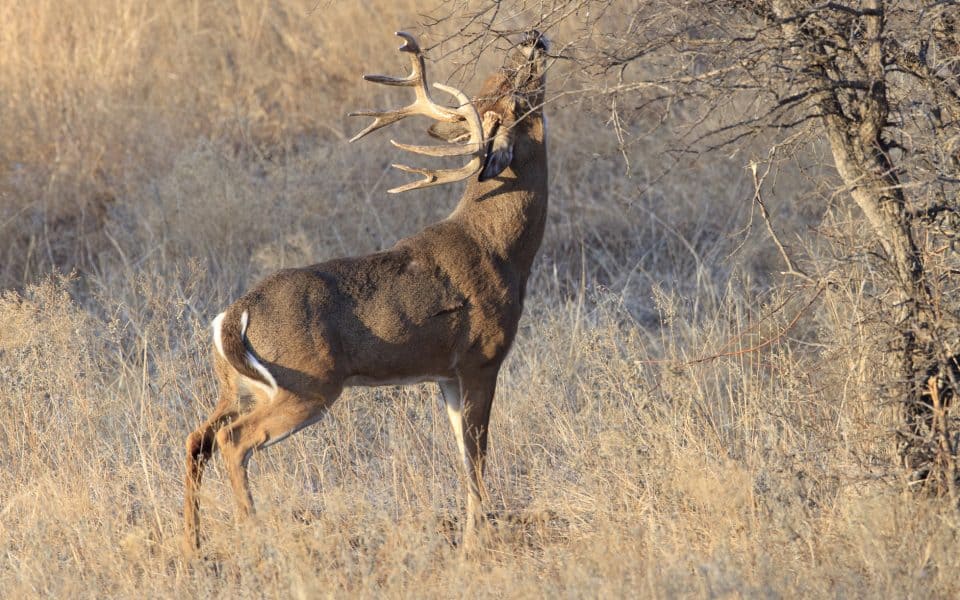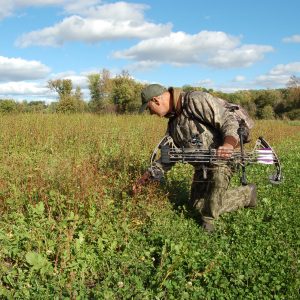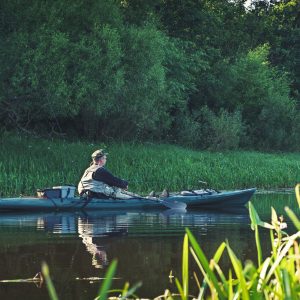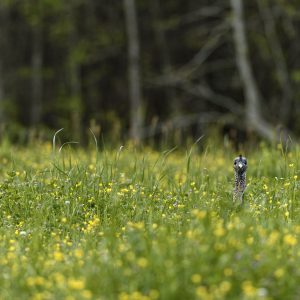The Big Picture on Scrapes
Scrapes are multi-stimuli posts that convey numerous messages to the other whitetails in the area. The majority of scrapes are made underneath an overhanging branch which is usually about 5½ feet off of the ground, commonly known as a “licking branch.” Most of the time when a scrape is made the buck will start by interacting with this branch by licking or chewing on it and scent-marking it with his forehead and preorbital glands. The actual scrape is made by the buck pawing the ground and whisking the leaves and ground debris away. Then, the majority of the time a buck will move ahead a step or two to urinate down his hocks and over his tarsal glands into it. The steps don’t have to be in that order, but most often they will occur in exactly that order.

Tom Reichner
Some call a scrape “a buck’s calling card to the does.” I disagree somewhat. I feel a scrape’s primary function is to be a buck’s “territory marker and breeding readiness indicator.” AND, it’s left for ALL of the deer in the area, possibly more so for the other bucks.
When a buck is actually breeding does, he may literally be miles away from his “scrape-claimed” territory. It’s really not like some used to think — a doe comes along, maybe pees near a buck’s scrape and then waits for him. While does may from time to time urinate near or even in a scrape, and they may also pay attention to the licking branch, when breeding gets underway, little attention is actually focused on any scrape.
It can also be explained away by the lack of scrapes in areas with an extremely skewed buck to doe ratio. In spots where there is an abundance of does and fewer bucks there is usually less scrape activity. There is less competition amongst the bucks and they are less territorial. Obviously, there are fewer bucks in an area if there are too many does, but with the bucks that are present, there is less scrape activity than normal because they don’t need to continually define territory or dominance.
There is a definite coalition between the size and amount of scrapes in an area and the buck to doe ratio and the age class structure in that specific herd. Larger scrapes typically do mean bigger deer; however, that’s not always the case.
Sometimes smaller bucks will work-over larger scrapes originally made by more mature, “breeding-class” bucks, and sometimes you may have a dozen bucks or more work over the same scrape. A greater majority of the scrapes made by one-year-old bucks are conceived and then never freshened again. The older bucks that get to do the majority of the breeding in an area will much more often create scrapes that are freshened again and again. And as said, many times these scrapes may be frequented by multiple bucks.
The scrape is a phenomenal scouting aid for the hunter. Yet, too many times hunters have similar claims, “The scrape was freshened every time I scouted, but I hunted it for days and never saw a buck.” First of all, you possibly over-hunted the site. Secondly, in most areas with a little hunting pressure, the greater majority of pre-rut scrapes are made nocturnally. Thirdly, you may be concentrating on scrapes too far away from the buck’s bedding area.
Instead of hunting one scrape, try to look at the big picture of the whole area. Look at the correlation between his scrapes and the rest of his domain. Where is he currently bedding? Where are the does in his area bedding and feeding? What time is he going to be there to freshen it up? A big point to keep in mind for choosing a stand site is; mature whitetail bucks, especially in areas with hunting pressure, usually “scent-check” an area from down-wind before approaching the scrape.
Mock Scrapes to Fool Mature Bucks
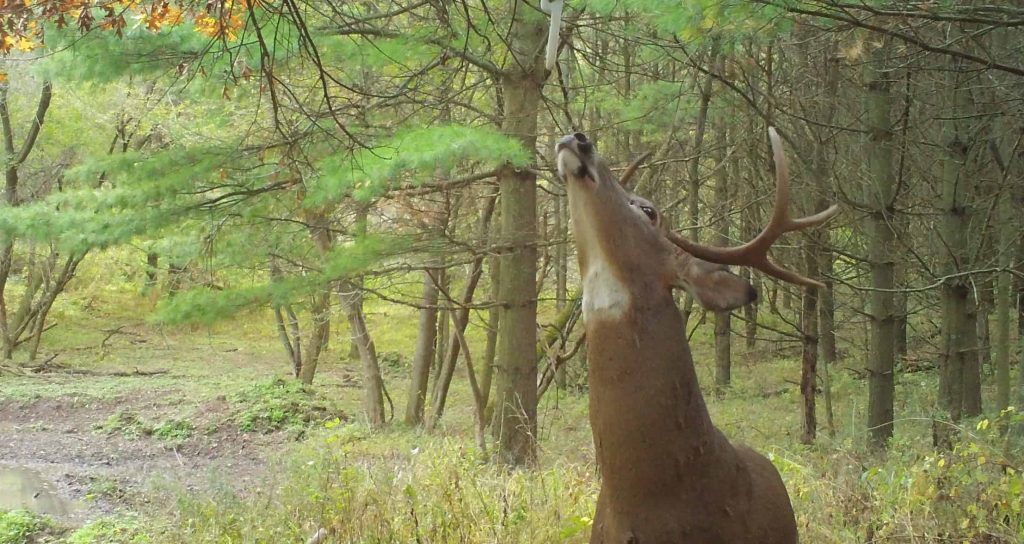
Using a buck’s scrapes as a focal point to get close enough for a shot is a proven tactic from late September through the end the season. However, it’s very difficult to know which scrape area a buck will visit, or when he’ll be there without the use of a scouting camera…or one of the coolest, most effective tools I’ve now been using for over 30 years — the Magnum Scrape Dripper… and I would also include the newer high-output Super-Charged Scrape Dripper.
These drippers are both heat-activated so they drip during daylight hours. This conditions bucks into showing up during legal shooting light and staying in the area longer. Hunting with Wildlife Research Center’s Drippers have produced again and again for me.
The Magnum Dripper can operate for up to three weeks on four-ounces of scent depending upon temperature swings. Both drippers are activated by the daytime temperature increase so they drip daytime only, again, conditioning bucks to show up before dark and hang around in the area longer. With bad weather, temperatures usually drop because of a cold front or cloud cover, so it saves your valuable scent from being washed away. The Super-Charged Scrape Dripper dispenses a higher output to simulate more intense deer traffic. That same four ounces of scent will typically last 7 to 12 days in this unit.
Both units have their place. You can’t beat the consistency and simplicity of the Magnum Dripper. It’s a constant reminder to the bucks in the area, training them to show up and hang around. On the other hand, let’s say you’re taking a week long hunt to another state. In this case, the Super-Charged Dripper can fire things up quickly, often within a day or two to take advantage of the limited time you have.
The drippers are most often best hung in a shaded area. Absorption of thermal heat from the sunlight can cause the dripper to run through all of the scent prematurely. With that said, during late season, when cold temperatures may freeze the dripper, I may purposefully hang it in a sunny spot to extend the usefulness of these cool tools. As long as the daytime highs break above freezing and hold for the day, it can still remain effective even if nighttime temps drop below freezing.
By using data collected from trail cameras that have been set up both, at mock scrapes, and existing scrapes without drippers, there’s no question that your odds are significantly better at scrapes, or scrape areas, that have drippers. However…
Where To Make a Mock Scrape
Targeting the right area is important. You can’t just go out to any branch that is 5½ feet off of the ground and expect to create a successful mock scrape. I tend to pay less attention to actual scrapes made on field perimeters and concentrate on ones closer to bedding areas.
Seek out an area that your target buck is already claiming. Move in and make it look and smell like there’s a rival buck moving in on his turf. Look for the areas with the largest scrapes, spots that contain numerous scrapes or clusters of scrapes, and scrapes that you know have been freshened again and again.
Wind directions obviously change, but I use the prevailing wind for that area at that time of year as my guide, and I prefer to make at least one, if not “the primary” mock scrape location a short distance upwind of the buck’s natural existing scrape. I also believe it’s best to be within fifty yards of the buck’s real scrapes, but it can work at any distance. Much depends upon the type of area (habitat and topography), timing, herd density and dynamics and the demeanor of that specific buck.
Once you find the area, search out the same type of tree with the same height licking branch of which the buck originally approved. As mentioned, the interaction branch is almost always about 5 to 5½ feet off of the ground, but can be anywhere from about 3½ feet high, to so high they have to stand on their hind legs to get to it. Try to duplicate the variables that the specific buck that you’re after preferred.
As a matter of fact, you can actually use the buck’s existing scrapes. In the whitetails’ world, the same scrape may be utilized by many different bucks. However, more often than not, I’ll make my own, trying to copy the specifics found with the buck’s existing scrapes.
How to Make a Mock Scrape
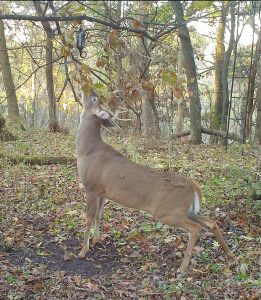
The actual mock scrape is best created with a sturdy stick found in the area. Try to make the scrape on flat ground if possible and make sure it is free from all debris. Remove all grass-roots or saplings. If you go back and check the site before you hunt it, go to the scrape and carefully rake-over the scrape again with a stick. I believe that the fresh earth smell created from disturbing the forest floor also helps to attract deer to the site.
Scent-Transfer
This is an important point at which to mention something about “scent-transfer.” It doesn’t matter whether you’re setting up a mock scrape, or using a buck’s already existing scrape, you must be cautious of scent-transfer. What smells are you leaving behind? We obviously want protect from leaving behind any smells that wouldn’t naturally appear at the site. When you hang the dripper, rubber gloves should be used to reduce the possibility that foreign odors, especially human scent is left at the scene. At the very least, a clean pair of hunting gloves that have been washed in Scent Killer Clothing Wash should be used — anything but your bare L-serine (human scent) saturated skin. Wearing rubber gloves, rubber-bottomed boots and clothing washed in Scent Killer Clothing Wash will help to avoid leaving foreign smells at the site.
To further keep unnatural odor to a minimum, I like to hang my drippers on a higher branch, above the licking branch. This keeps them from getting a good whiff of any foreign odors that may have permeated the dripper’s cloth cover.
On the same note, the actual scrape doesn’t have to be made with a sturdy stick found in the area – I’ve used rakes, shovels, machetes, axes and other things at hand, but you must make sure that it’s NOT the rake that’s been hanging near your car’s exhaust in your garage, or the axe you used to prop up your chainsaw when you filled it with gas…get the idea?
I may use numerous drippers and possibly vary the scent used in each. I believe with more than one “mock” you’re increasing your chances that something’s going to be right with at least one of them that will draw a response. Multiple scrapes is the way a real rival buck would announce his presence. With several mock scrapes usually there’s something right with at least one of them that will draw a response.
How Many Mock Scrapes Do You Need?
Two will increase your odds, but I’ve made as many as a dozen in an area of about one acre with success. Most hunters do not own multiple drippers, so use as many as you can afford on the scrapes that you feel the most confident in drawing a response and just “doctor-up” the others with fresh scent each time you physically enter the area. Felt wicks can also be used near the licking branch, but they don’t last nearly as long as the scent in a dripper and no scent is dripped down to the actual scrape itself.
What Scents to Use
My two favorite scents have always been Active Scrape, and Trail’s End #307 used in the dripper, but I would add Golden Scrape to that list. Actually, any liquid scent can be used in the dripper. In fact, these “dripper twins” make great tools for dispensing scent at other scent set-ups; it doesn’t have to be used only at mock scrapes. If you have a chance to check on your mocks before you hunt them, and preference is shown towards one scent, I might change all of the drippers over to that one scent.
Mock Rubs
Consistent with just about every successful mock scrape set-up I have are the “mock rubs” that I also produce. With a pruner or wood rasp, I rake up some two to six inch saplings in the area. A real intruder buck would typically also mark the area in this way. On the rubs, and in various other places around the set-up, I use a scent called Mega Tarsal Plus. It’s a territorial intrusion scent. The illusion I want to create is that a foreign buck has moved in on his marked area.
Timing Your Mock Scrapes
Timing is also important for mock scrapes to work. In the Midwest I seem to have my best luck from the first or second week of October through the first week of November. And, then again after Thanksgiving and into the first part of December. When the bucks are actively chasing and breeding, mock scrapes are probably not your best tactic. You want the bucks to be in “claiming and protecting territory mode.” Although whitetails don’t define and protect a territory per se, you want to leave him a message that someone else is moving in on his action.
No Licking Branch, No Problem
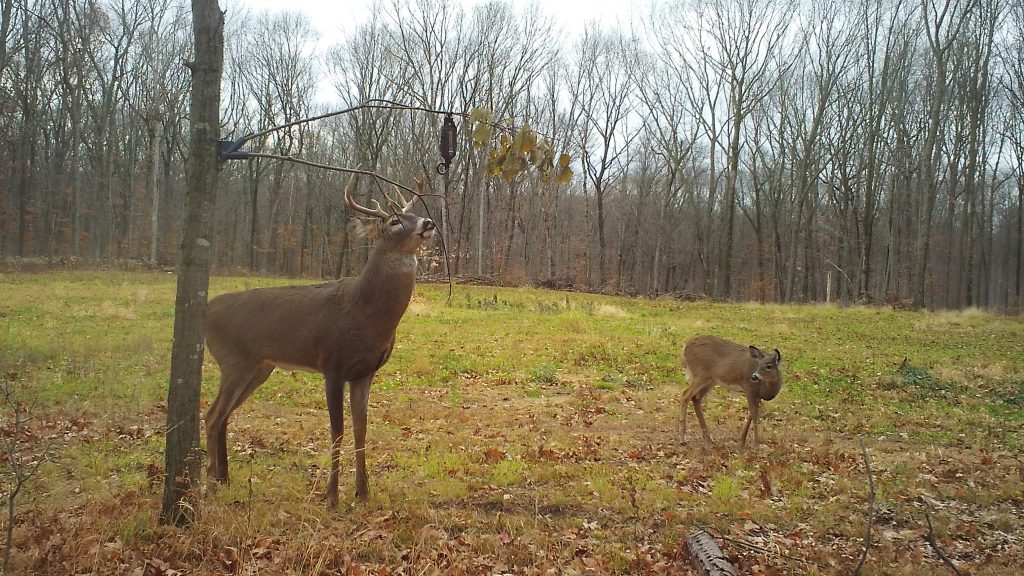
There has been some research in recent years that has found that licking branches transported from a buck’s real existing scrape to different locations will work, hemp rope in place of a licking branch will work, but the coolest tool to make it easy is the new Active Branch. With it you can erect a perfect height licking branch on trees, fence posts or anywhere you can attach the Active Branch at the magic 5½-foot mark. It even has an extra position so you can insert a branch above the actual licking branch to hang your dripper.
Don’t expect your mock scrape(s) to necessarily get hit, remember that’s not the objective. Sometimes they may actually cream your fake scrape, but the goal is simply to “draw them to the area during legal shooting light and hold them there for a longer period of time.” However, sometimes they do hit your mock scrapes, and sometimes you’ll have multiple bucks interact with them.
A hunter should use all other aids and information in conjunction with scrapes found in their hunting area. Know where the does are bedding, what the preferred food sources are at that time, where your target buck is bedding, and where he may have other hot scrape areas. Take in the “big picture” of the area and use the buck’s entire range in relationship with other factors before making your mock scrape set-up.

